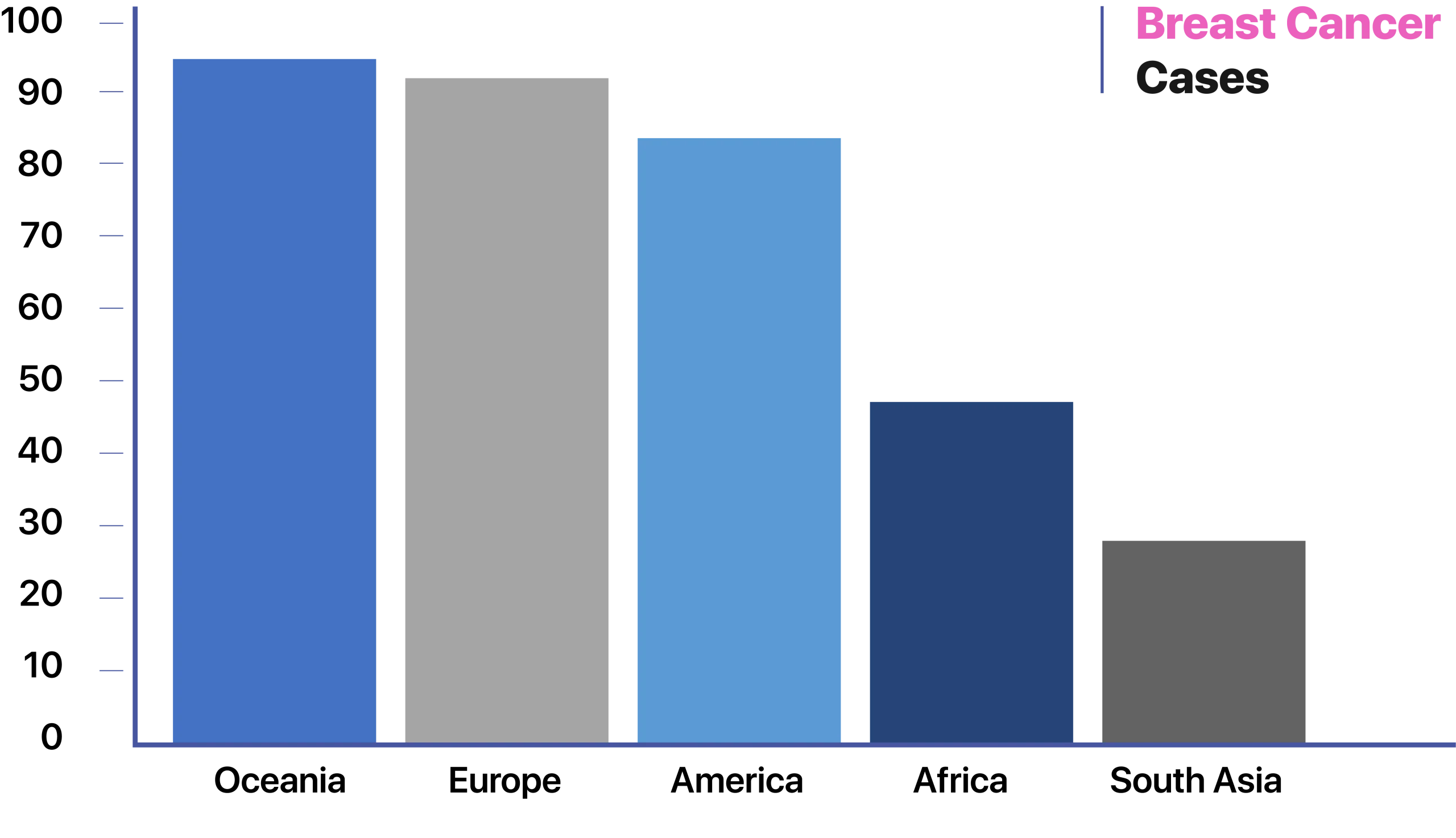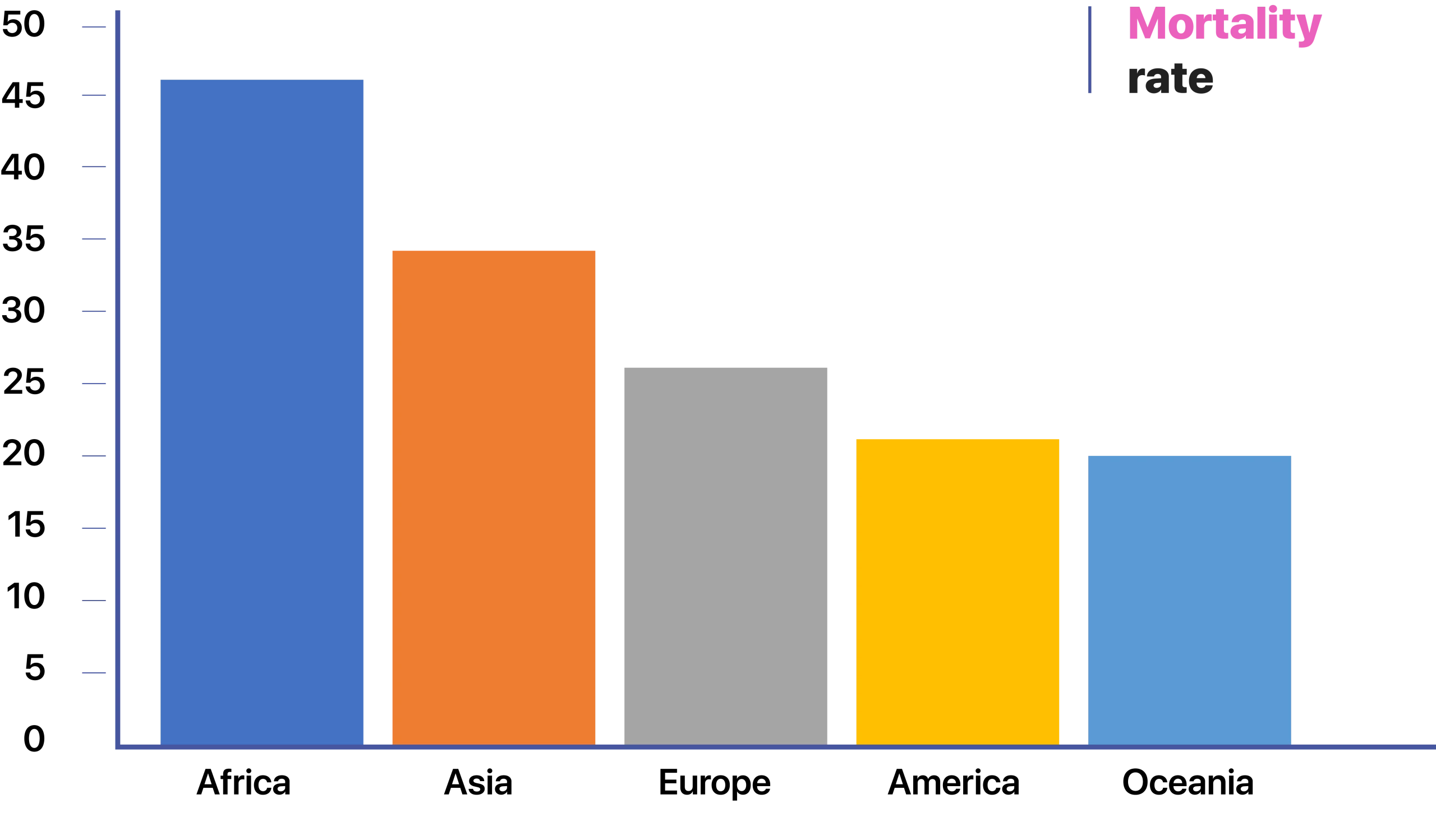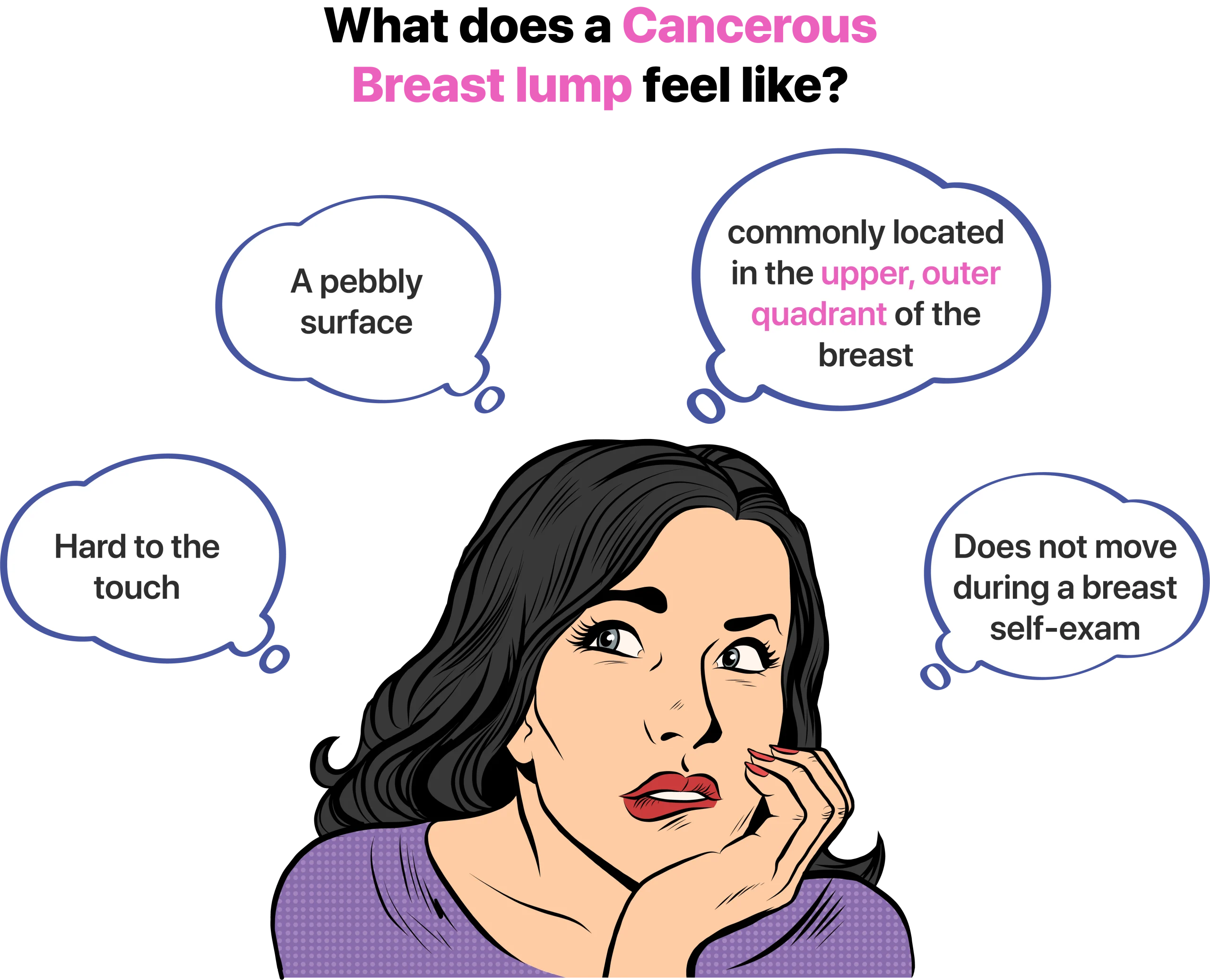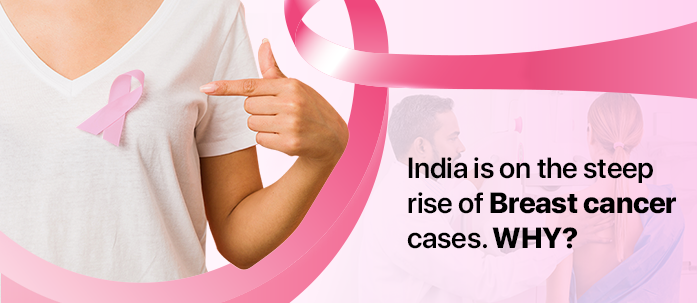Isn’t it unusual for each one of us to know at least one person who’s either diagnosed, succumbed to, or defeated Breast cancer in their lifetime?
Well, this sheds a light on why Breast cancer cases are on the extreme rise in India.
From being fourth in the list of most common cancer cases in the 90s to achieving the top position, Breast cancer cases are taking sharp turns to achieve different milestones in terms of increased mortality. In simple words, India’s Breast cancer burden is increasing at an alarming rate, and the question is why?
From symptoms to diagnosis to facts to common questions asked- this article will cover everything related to Breast cancer.

Why Breast cancer is at an alarming stage in India?
Breast cancer is 100% treatable if detected early. Although the prevalence of Breast cancer is more in most developed countries (Fig 1) the rate of mortality (death) is huge in Asian countries (Fig 2). The reasons behind this disparity are a lack of awareness, the complex nature of the disease, and the taboo associated with the disease. The majority problem lies in less specific and low-precision detection because of underdeveloped medical infrastructure in most parts of the countries. Early detection and early treatment is the key to the battle against this disease.

A comparison of the Breast cancer rate of incidence among different countries (WHO, 2020)

Difference in mortality rate among different countries (WHO, 2020)
Stages of cancer
A lump in the breast marks the first sign of related cancer- Not true! Development of cancer could take 2 to 5 years before the first sign and/or until it is diagnosed. However, most women usually have non-cancerous lumps (benign in nature), that may or may not turn malignant in later stages of life. Different stages of breast cancer are given below;
- Stage 0: This is the first warning sign of cancer. There may be abnormal cells in the area, but they have not spread and can’t be confirmed as cancer yet.
- Stage 1: This is the earliest stage of breast cancer. The tumor is no bigger than 2 centimeters. Although confined to the breast alone, some minuscule cancer clusters may be present in the lymph nodes.
- Stage 2: This signifies that cancer has started to spread. Cancer may be in multiple lymph nodes, or the breast tumor is more significant than 2 centimeters.
- Stage 3: Doctors consider this a more advanced form of breast cancer. The breast tumor may be large or small and may have spread to the chest and to several lymph nodes. Sometimes cancer has invaded the skin of the breast, causing inflammation or skin ulcers.
- Stage 4: Cancer has spread to other distant parts of the body like bones, lungs, liver, and brain.
Symptoms of Breast cancer
A body undergoes many changes in the case of breast cancer, there are many symptoms other than lump formation, to detect cancer- 90% of breast lumps are not cancerous. Non-cancerous breast abnormalities include benign masses like fibroadenomas and cysts as well as infections but one should always be cautious and get medical help as soon as possible.
Other symptoms that should be taken into consideration are:
- Swelling in all or in a part of a breast
- Skin dimpling
- Breast or nipple pain
- Inward retraction of the nipple
- Red, dry, flaking, or thickened Nipple or breast skin
- Nipple discharge or blood from the nipple (other than breast milk)
- Swollen lymph nodes under the arm or near the collar bone, a sign that breast cancer has already spread even before the original tumor in the breast is large enough to be felt
Types of breast cancer
Is defined as when an epithelial cell of any tissue present in the breast turns carcinogenic. When cells of the milk ducts turn carcinogenic the type of cancer is called ductal cancer. And when the emergence of cancer is from lobules, where the milk is produced the type is called lobular cancer.
They are also divided on the basis of cancer. Insitu is mostly the pre-cancer stage, is tissue-specific, and has not spread to different tissues of the breast. In contrast to that invasive types are those that have already spread to different tissues in the breast, and usually comes in later stages.
Dwelling into more complexity the breast cancer cells can be again divided into types of hormone receptors present. Receptors are proteins present on the cell surface and can attach to different substances in the blood. It is essential to understand different receptors on the cell. Prior knowledge plays a keen role in formulating the patient’s treatment plan. A biopsy will confirm the presence or absence of these receptors ( YodaDiagnostics )
Different types of receptors present are
- Estrogen Receptor: Cells that have this receptor are called ER(+) or else called ER(-)
- Progesterone Receptor: presence or absence of these receptors is called PR(+)or PR(-)
- Double-negative breast cancer refers to tumors that lack the expression of estrogen (ER) and progesterone receptors (PR). Double-negative cancers comprise 18-25% of breast tumors.
- Triple-negative breast cancer has been applied to cancers that lack expression of the estrogen receptor (ER), progesterone receptor (PR), and human epidermal growth factor receptor 2 (HER2). TNBC tends to behave more aggressively than other types of breast cancer
- Another protein Ki-67 is assessed to understand how fast the tumor is growing
How do genetics play a role in combating breast cancer?
Let us understand the molecular basis of cancer. In order to survive each cell will undergo a cell cycle, where the cell division is bound to be strictly controlled. Sometimes a few genes are mutated and a cell becomes immortal (undergoes uncontrolled division).
BRCA1, BRCA2, CDH, and TP53 are a few genes that help in DNA homeostasis. Mutation encountered in these genes results in unchecked cell division and ultimately abnormal growth.
These mutations are more likely to be triggered by carcinogens in our environment, chemicals in tobacco smoke, UV rays from the sun, etc, a definite trigger point is unknown.
If you have a family history of Breast cancer it’s most likely that the mutated genes are inherited and might have greater chances of developing cancer. Angelina Jolie, a famous Hollywood celebrity, lost her mother, grandmother, and aunt due to cancer. She was advised to undergo genetic testing- The genetic tests look for gene mutations that can predict the likelihood of any disease. The actress screened positive for the BRCA1 mutation. Indicating her likelihood of developing breast cancer. She underwent a double mastectomy and is now leading a normal life. Hence, genetic testing plays an important role to understand what’s encrypted in the genes and combating different types of cancer.
Diagnosis for Breast cancer
There are different steps for Breast cancer diagnosis. Every woman should take a self-assessment test for breast cancer at home. Because self-examination is the key to better understanding our own bodies. If you feel any lumps or any above-given symptoms, act now and get a health assessment as quickly as possible. Yoda follows a 5-step diagnosis for cancer detection
- Screening: Physical examination by a professional practitioner to check phenotypes of breast cancer.
- Mammography: It uses low-energy x-ray for examining the human breast for screening and diagnosis of lumps.
- Biopsy: These tests are performed to understand the malignancy status and severity of the cancer cells. These pathology tests check for different
- Histopathology studies: Marker testing for ER, PE, Her2/Neu translocation, and Triple negative Maker testing to determine treatment options
- Whole Exome screening (NGS): NGS identifies translocations and mutations in different genes. Yoda offers Predictive screening and genetic workup for cancer diagnosis

Why is Yoda the best for cancer diagnosis?
Yoda is the fastest-growing diagnostic chain in India. In no time we have won over thousands of hearts by providing the best, most specific, and most effective diagnosis of simple to complex diseases.
- Yoda has a comprehensive workup for Screening and diagnosis of Brest cancer involving Radiology, pathology, and genomics workflow.
- Our hereditary cancer panel covers all types of cancer including breast cancer (only 10% of breast cancer cases have a genetic basis)
- We offer genetic testing to enable an individual to assess the risks if breast cancer runs in the family.
- We have all the tests under one roof from
- Physical examination
- Mammogram
- Radiology/ ultrasound
- Biopsy
- Pharmacogenomics
- We provide free pre and post-genetic counseling services to decrease the disease odyssey a patient and family members have to undergo. And help them to make more informed decisions.
- For precise management of the disease, we also do pharmacogenomic analysis. Now no hit-and-trial methods when it comes to your health.

Common questions related to breast cancer
- Is Breast cancer a gender-specific disease? Breast cancer in males is taboo! WELL NOT REALLY. Although the occurrence is 100 times more in women than men, each one of us is prone to the disease. Breast cancer is rare but also happens in children too.
- Are all breast cancers inherited? Approximately 10% of breast cancer cases are hereditary, which means the origin of the rest 90% of breast cancer cases is unknown. It might be exposure to radiotherapy, hormonal treatments, or carcinogens. Yoda offers a germ-line cancer panel to assess the inheritance of any type of cancer available
- Does estrogen play a role in Breast cancer? Yes. Estrogen is one of the reasons for breast cancer. Late menopause or early menarche induces higher levels of estrogen. Hormonal treatment may induce Breast cancer.
- How effective is mammogram screening? Mammograms check is necessary but, whether it could detect cancer depends upon the sensitivity of the machine. Get your diagnosis at a place where there’s the availability of high-end machinery and experienced technical staff.
- At what stage Breast cancer is detected? It is one of the most difficult questions to answer. The lump could be there for 2 to 5 years before it could be detected/ felt. Sometimes the cancerous cells originated at the armpit lymph nodes not even in the breast resulting in the rapid spread of cancer cells throughout the body. Studies have shown men are more prone to breast cancer because of a lack of awareness. As the prognosis is late it’s most likely that the treatment will also be delayed.
- Does breast cancer differ in race or ethnicity? Sadly it does. Studies have shown Black women are more prone to aggressive types of triple-negative breast cancer as compared to others. Genomic and pharmacogenomics could play an important role in understanding India-specific (control) differences. Genomics may enable the identification of women at high risk of developing cancer, where targeted screening may be cost-effective. There is an urgent need to identify Indian-specific genetic/epigenetic biomarkers. These may have the potential to be used as biomarkers for early detection at the screening stages.
- Why are older women more prone to Breast cancer? Yes, breast cancer is age specific. Women ages 40 or more should undertake breast self-examination once a month and mammogram testing at least once a year because they are more prone to DNA mutations (due to many different reasons) that may or may not be repaired by the body.
Don’t wait for your lump to get bigger, Screen sooner!

Breast cancer is 100% treatable if detected and intervene early.
























